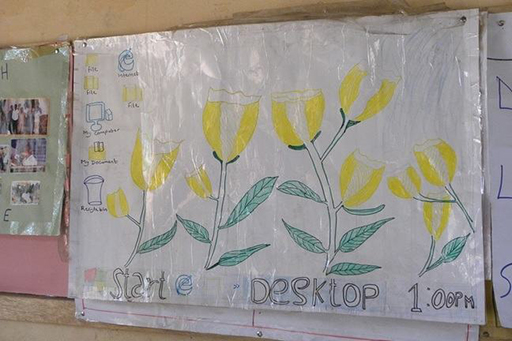Using ICT in the classroom

Students and student teachers often have more knowledge and experience of ICT than teachers and teacher educators. Effectively embedding ICT requires learner-centred attitudes and values. The downloadable document ‘Is your teaching learner-centred?’ from section 2 will be helpful to you in this section.
If you are working through this course with colleagues, you may wish to do this next activity as a ‘Think, Pair, Share’. If you are working on your own, compare your response with our ideas.
Activity 3.1: An example of using ICT
Read the two case studies below in which ICT is used as part of a lesson. As you read each one, make notes on the positives and negatives of the teacher’s approach to technology. You may want to use these two case studies and the following questions with your own student teachers to encourage them to think about the use of technology in their own teaching.
Case Study 1
Mr Shabukali’s school has just installed digital projectors and all staff are being encouraged to use them in their classes. Mr Shabukali is not very happy about this as he is not very experienced with using technology, but decides that he will make a PowerPoint for his next English lesson. He is teaching the past simple irregular verbs, so he makes a table with two columns – one for the infinitive and one for the past tense – and copies it onto some PowerPoint slides.
In the classroom he puts on the PowerPoint and then tells his students to copy the table into their notebooks in silence. It’s quite difficult for the students at the back to see the slide, but Mr Shabukali is a very strict teacher and they are nervous about telling him so they say nothing.
While the students are copying the slides, the teacher sits at his desk looking at his laptop. He realises that he has made two mistakes on the first slide: blow/blowed and hurt/hurted. He quickly moves onto the next slide, although most of the students have not finished copying the first slide. But there’s another mistake on the second slide (ring/runged). He quickly switches off the laptop and tells the students to open their books and do the exercise on page 21.
Case Study 2
Mrs Bwalya works in the same school. She has a different approach to technology to her colleague and wants to use it to get her students talking to each other. She chooses pictures that she has found online showing the life cycle of a frog. She shows her students the pictures by connecting her phone to the projector. Mrs Bwalya puts her students in groups of four and explains that the pictures have been mixed up so that they’re in the wrong order. In their groups they have to reorganise the pictures and then write down the life cycle.
As the students are working, Mrs Bwalya moves around the classroom, helping different groups of students with any problems she can see that they are having. She is surprised to see that one of the quickest students is a very quiet boy who doesn’t often take part in class activities. When all the groups have finished, she asks his group to put the pictures into the right sequence. When the class has agreed that this is correct, she brings different students to the board to check that all the students understand and can spell the key vocabulary.
Next, note your responses to the following questions:
- How could Mr Shabukali use PowerPoint in a more learner focused way to encourage active learning?
- How does Mrs Bwalya’s approach to technology compare to the approach taken by Mr Shabukali? What are the strengths of her activity? Can you think of ways to improve it?
- Now listen to the audio file. In this you will hear a member of the course team explaining what they understood from these examples.
Transcript
Mr Shabukali uses the PowerPoint in a very restrictive way. He could ask the students to spot the errors and correct them, even turning it into a speed reading game between groups. Another way to make learning more student-centred is to leave gaps and ask students either individually, in pairs or in small groups, to complete the table. That way the PowerPoint can be used as formative assessment, checking that students understand the content being copied. It’s also important to make sure that everybody can read the screen. You can do this by moving around the room – it’s easy to enlarge text size if you find it’s too small for some of the students.
In the second example, Mrs Bwalya takes a more creative approach to using technology, involving group work and active learning. Her role is to monitor the learning and see which students have difficulties. Did you notice how her lesson moved forward from the stimulus of the technology, and she made sure the students were all aware of the key vocabulary? She could extend this by asking the learners to write a short paragraph on the lifecycle of the frog.
You can also download a copy of the transcript.
Introduction



